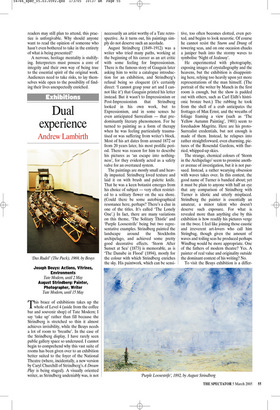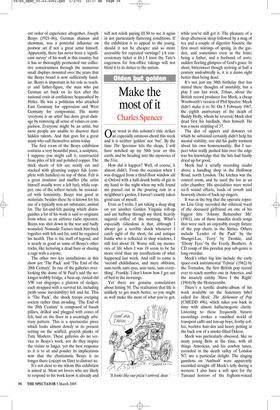Dual experience
Andrew Lambirth
Joseph Beuys: Actions, Vitrines, Environments Tate Modern, until 2 May August Strindberg: Painter, Photographer, Writer Tate Modern, until 15 May
This brace of exhibitions takes up the whole of Level 4 (aside from the coffee bar and souvenir shop) of Tate Modern; I say ‘take up’ rather than fill because the Strindberg is stretched so thin it almost achieves invisibility, while the Beuys needs a lot of room to ‘breathe’. In the case of the Strindberg display, I have rarely seen public gallery space so underused. I cannot begin to comprehend why this vast suite of rooms has been given over to an exhibition better suited to the foyer of the National Theatre (where, incidentally, a new version by Caryl Churchill of Strindberg’s A Dream Play is being staged). A visually oriented writer, as Strindberg undeniably was, is not necessarily an artist worthy of a Tate retrospective. As it turns out, his paintings simply do not deserve such an accolade.
August Strindberg (1849–1912) was a writer who tried many paths, working at the beginning of his career as an art critic with some feeling for Impressionism. There is the famous story of Gauguin later asking him to write a catalogue introduction for an exhibition, and Strindberg’s refusal being so eloquent (it’s certainly direct: ‘I cannot grasp your art and I cannot like it’) that Gauguin printed his letter instead. But it wasn’t to Impressionism or Post-Impressionism that Strindberg looked in his own work, but to Expressionism, and in some senses he even anticipated Surrealism — that predominantly literary phenomenon. For he turned to painting as a form of therapy when he was feeling particularly traumatised or was suffering from writer’s block. Most of his art dates from around 1872 or from 20 years later, his most prolific period. There was reason for him to describe his pictures as ‘an escape into nothingness’, for they evidently acted as a safety valve for an overtaxed system.
The paintings are mostly small and heavily impasted. Strindberg loved texture and laid it on with brush and palette knife. That he was a keen botanist emerges from his choice of subject — very often restricted to a solitary flower on the sea shore. (Could there be some autobiographical resonance here, perhaps? There’s a clue in one of the titles. It’s called ‘The Lonely One’.) In fact, there are many variations on this theme, ‘The Solitary Thistle’ and ‘Purple Loosestrife’ being but two representative examples. Strindberg painted the landscape around the Stockholm archipelago, and achieved some pretty good decorative effects. ‘Storm After Sunset at Sea’ (1873) is memorable, as is ‘The Danube in Flood’ (1894), mostly for the colour with which Strindberg enriches the sky. His paintwork, which can be sensi tive, too often becomes clotted, even petted, and begins to look neurotic. Of course he cannot resist the Sturm und Drang of towering seas, and on one occasion chucks a juniper bush into the stormy waves to symbolise ‘Night of Jealousy’.
He experimented with photography, exposing images of crystallography and the heavens, but the exhibition is disappointing here, relying too heavily upon yet more representations of the man himself. (The portrait of the writer by Munch in the first room is enough, but the show is padded out with others, such as Carl Eldh’s histrionic bronze bust.) The rubbing he took from the shell of a crab anticipates the frottages of Max Ernst, and the wreaths of foliage framing a view (such as ‘The Yellow Autumn Painting’, 1901) seem to foreshadow Magritte. Here are his protoSurrealist credentials, but not enough is made of them. Instead, he relapses into rather straightforward, even charming, pictures of the Rosendal Gardens, with flurried, whipped-up skies.
The strange, chemical colours of ‘Storm in the Archipelago’ seem to promise another avenue of investigation, but it is not pursued. Instead, a rather wearying obsession with waves takes over. In this context, the good name of Turner is bandied about; yet it must be plain to anyone with half an eye that any comparison of Strindberg with Turner is idiotic and utterly misplaced. Strindberg the painter is essentially an amateur, a minor talent who doesn’t deserve such exposure. For what is revealed more than anything else by this exhibition is how readily his pictures verge on the twee. I feel like joining those caustic and irreverent art-lovers who call him Stringbag, though given the amount of waves and toiling seas he produced perhaps Windbag would be more appropriate. One of the fathers of modern theatre? Yes. A painter of real value and originality outside the dominant context of his writing? No.
To visit the Beuys exhibition is a differ ent order of experience altogether. Joseph Beuys (1921–86), German shaman and showman, was a powerful influence on postwar art if not a great artist himself. Apparently, there has never been a ‘significant survey’ of his work in this country, but it has so thoroughly permeated our collective consciousness through the numerous small displays mounted over the years that the Beuys brand is now sufficiently familiar. Beuys is important in his role as teacher and father-figure, the man who put German art back on its feet after the national crisis in confidence bequeathed by Hitler. He was a politician who attacked East Germany for oppression and West Germany for compromise. His motto ‘everyone is an artist’ has done great damage by removing all sense of values or comparison. Everyone might be an artist, but most people are unable to discover their hidden talents. And that goes for a great many who call themselves artists today.
The first room of the Beuys exhibition contains a very beautiful piece, a sculpture, I suppose you might call it, constructed from piles of felt and polished copper. The thick sheets of felt are neatly cut and stacked with gleaming copper lids (complete with handles) on top of them. Felt is a great insulator and muffler (the artist himself usually wore a felt hat), while copper, one of the softest metals, he associated with femininity. Beuys was good at materials: besides these he is known for his use of a typically non-art substance, animal fat. The fat-and-felt pairing which distinguishes a lot of his work is said to originate from when, as an airforce radio operator, Beuys was shot down in the war and badly wounded. Nomadic Tartars stuck him back together with felt and fat, until he regained his health. This is the stuff of legend, and is nearly as good as some of Beuys’s other tricks, like lecturing a dead hare or sharing a cage with a coyote.
The other two key installations in this show are ‘The Pack’ and ‘The End of the 20th Century’. In one of the galleries overlooking the dome of St Paul’s and the nolonger wobbly bridge, a beat-up, rusted old VW van disgorges a platoon of sledges, each strapped with a survival kit, including (with some inevitability) felt and fat. This is ‘The Pack’, the shock troops escaping society rather than invading. ‘The End of the 20th Century’ is composed of basalt pillars, drilled and plugged with cones of felt, laid on the floor in a seemingly arbitrary pattern. This is a spectacular piece which looks almost dowdy in its present setting on the scuffed, greyish planks of Tate Modern. These galleries do no service to Beuys’s work, nor do they inspire the visitor to linger, yet the best response to it is to sit and ponder its implications now that the charismatic Beuys is no longer there (except on film) to distract us.
It’s not clear to me whom this exhibition is aimed at. Most art lovers who are likely to respond to his work know it already and will not relish paying £8.50 to see it again in not particularly flattering conditions. If the exhibition is to appeal to the young, should it not be cheaper and so more accessible for repeated viewings? (A concessionary ticket is £6.) I trust the Tate’s eagerness for box-office takings will not blind it to its duties to the nation.



























































 Previous page
Previous page